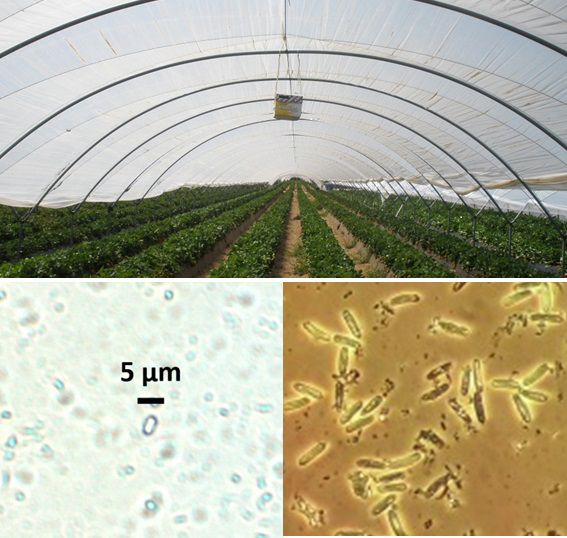The use of commercial bumblebees to aid crop pollination may result in overcrowding of agricultural landscapes by pollinators. Consequently, transmission of parasites between pollinators via shared flowers may be substantial. In SW Spain, the authors assessed the initial infection status of commercial Bombus terrestris colonies and then explored spatial and seasonal influences on changes in parasite prevalence across a landscape where bumblebee colonies are intensively used to pollinate berry crops. Colonies were placed inside strawberry greenhouse crops and in woodlands adjacent and distant to crops, in winter and in spring, as representative periods of high and low use of colonies, respectively. Worker bumblebees were collected from colonies upon arrival from a producer and 30 days after being placed in the field. The abdomen of each bumblebee was morphologically inspected for a range of internal parasites. Upon arrival, 71% of the colonies were infected by spores of Nosema. Three bumblebees from two colonies harboured Apicystis bombi spores at the end of their placement in woodlands adjacent to the crops. Nosema colony prevalence did not change significantly either among sites or between seasons. No evidence was found for the density of commercial B. terrestris impacting Nosema prevalence in those commercial colonies, but results highlight the potential risk for parasites to be transmitted from commercial bumblebees to native pollinators. informacion[at]ebd.csic.es: Trillo et al (2019) Prevalence of Nosema microsporidians in commercial bumblebees (Bombus terrestris) is not related to the intensity of their use at the landscape scale. Apidologie https://doi.org/10.1007/s13592-019-00637-4
https://link.springer.com/article/10.1007%2Fs13592-019-00637-4  Latest News
Latest News
 Las altas temperaturas están provocando que las lagunas y las marismas de Doñana pierdan agua rápidamente
Las altas temperaturas están provocando que las lagunas y las marismas de Doñana pierdan agua rápidamente
La superficie inundada en la marisma es de un 78% pero la profundidad es escasa. Por otra parte, sólo el 1,9% de las lagunas temporales están inundadas. Las precipitaciones crean una oportunidad...
 Traffic noise causes lifelong harm to baby birds
Traffic noise causes lifelong harm to baby birds
A study with CSIC participation reveals for the first time that car noise harms individuals throughout their lifetime even years after exposure
 Illegal wildlife trade, a serious problem for biodiversity and human health
Illegal wildlife trade, a serious problem for biodiversity and human health
A research team led by the Doñana BIological Station and the University Pablo de Olavide have detected wild-caught pets in 95% of the localities in the Neotropic and warns of the risk of zoonotic...
 Urbanization and loss of woody vegetation are changing key traits of arthropod communities
Urbanization and loss of woody vegetation are changing key traits of arthropod communities
Urbanization is favouring smaller beetle species and larger spider species with greater dispersal capacity.
The loss of woody areas is linked to a decline in the duration of the activity...
The loss of woody areas is linked to a decline in the duration of the activity...
 Blood lead levels in an endangered vulture species decreased following restrictions on hunting practices
Blood lead levels in an endangered vulture species decreased following restrictions on hunting practices
Canarian Egyptian vulture was on the verge of extinction at the end of the 20th century. At that time, studies revealed that lead poisoning was a serious problem for the population’s survival. The...
— 5 Items per Page
 Asset Publisher
Asset Publisher
Back






